To read the full report, please download PDF.
USD selling can extend still further
FX View:
The US dollar (DXY) yesterday hit the lowest level since March 2022 with momentum remaining negative today despite the indications from the Trump administration that up to 10 trade deals could be signed before the reciprocal tariff suspension expires on 9th July. The focus for the FX markets has shifted back to macro fundamentals with Fed speakers this week suggesting there is a possibility that the FOMC could cut rates in July. Next week’s jobs data and the CPI data on 15th July will be crucial in determining that and clear undisputed weakness is likely required for a cut to come as soon as July. Still, expectations of rate cuts in 2026 have come down too and this move lower in fed funds expectations has hurt the dollar. If the jobs data is weak next week and we get numerous trade deals signed that helps lift optimism over global growth, we would likely see the dollar selling extended further. This week we assess the outlook for the Canadian dollar following the sharp drop in crude oil prices and look at the prospects for the pound in light of data suggesting the risks of back-to-back rate cuts from the MPC are rising.
USD WEAKNESS ACROSS G10 WITH OIL-RELATED FX UNDERPERFORMING
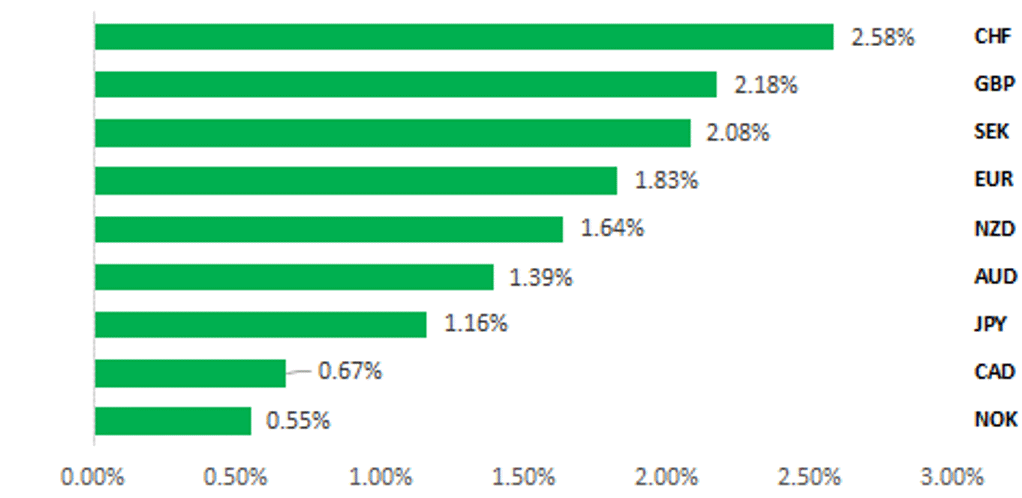
Source: Bloomberg, 13:35 BST, 27th June 2025 (Weekly % Change vs. USD)
Trade Ideas:
We have opened up a short USD/NOK trade idea. We want to hold a short dollar position and believe NOK could play catch-up to the broader dollar sell-off now that the Middle East risk has subsided.
JPY Flows:
This week we take at the weekly flow data and OTC margin positioning data. The weekly flows indicate foreign investors turned sellers of Japanese equities after eleven consecutive weeks of buying.
FX Momentum Strategies - G10 Majors in Focus:
The strength of EUR/USD signal offers a clear directional bias. The model’s historical performance suggests that this is not just a short-term anomaly but part of a broader, statistically supported trend. In contrast, GBP/USD signal should be considered amongst other metrics, while USD/JPY should remain monitored until a clearer momentum signal emerges.
FX Views
CAD: Weighing up risks for CAD after Middle East tensions ease
The CAD has strengthened over the past week resulting in USD/CAD dropping back towards the 1.3600-level after hitting a high of 1.3798 on 23rd June. The move lower in USD/CAD has been mainly driven by the broad-based reversal of USD gains triggered by the de-escalation of geopolitical tensions in the Middle East after a ceasefire was agreed to end the military conflict between Israel and Iran. While the CAD has strengthened against the USD, it has underperformed against other G10 currencies. It has been the third worst performing G10 currency since 23rd June after the USD and NOK. The CAD and NOK have both been undermined by the sharp decline in the price of oil with Brent falling back below USD70/barrel. Before recent oil supply disruption risks, the price of oil had been trading at weaker levels this year reflecting a “well supplied” market according to the International Energy Agency. The IEA’s June 2025 Oil Market Outlook Report revealed that they expect only modest growth in world oil demand this year of 720k b/d coming in below world supply growth of 1.8m b/d. Without a negative supply shock, the fundamental backdrop remains unfavourable for the price of oil and related currencies such as the CAD and NOK.
The sharp drop in the price of oil should help to dampen upside risks to inflation ahead of the BoC’s next policy meeting on 30th July. Like the Fed, the BoC is expected to leave rates on hold in the near-term until it has evidence to dampen concerns over upside risks to inflation from tariffs. The Canadian rate market is currently pricing in around 9 bps of BoC rate cuts by 30th July policy meeting. The release this week of the latest Canadian CPI report for May provided some relief revealing that core inflation measures eased back to 3.0% after picking up from around 2.5% at the start of this year. A further loosening of labour market conditions in next week’s Canadian employment report would support further policy easing as well. The unemployment rate hit a fresh cyclical high of 7.0% in May and has now risen by around 2 percentage points from the low point in 2022.
The BoC is likely to have more clarity over trade policy at the 30th July policy meeting. At the recent G7 summit, US President Trump and Canadian Prime Minister Carney committed to pursue a deal within the next month aimed at building a “new economic and security relationship”. Potential disruption for Canada from the looming 9th July “reciprocal tariff” deadline should be more limited given the current lower tariff rate of 10% should remain the same even if a deal is not reached and/or the deadline extended. Canada has warned though that it may impose counter tariffs by 21st July if no deal is reached. Overall, it suggests that risks are more tilted to the upside for Canada’s economy and the CAD from ongoing trade negotiations as it more likely tariffs will be lowered rather than raised further. The implications for the BoC’s policy decision in July from a trade deal would be less clear cut. On the one hand a trade deal would help to ease downside risks to growth going forward but on the other hand it would ease upside risks to inflation in the near-term. The BoC could take advantage of less inflation risk to deliver further easing to provide more support for growth.
CAD REMAINS WEAK VS. OTHER G10 FX (EXCL. USD)
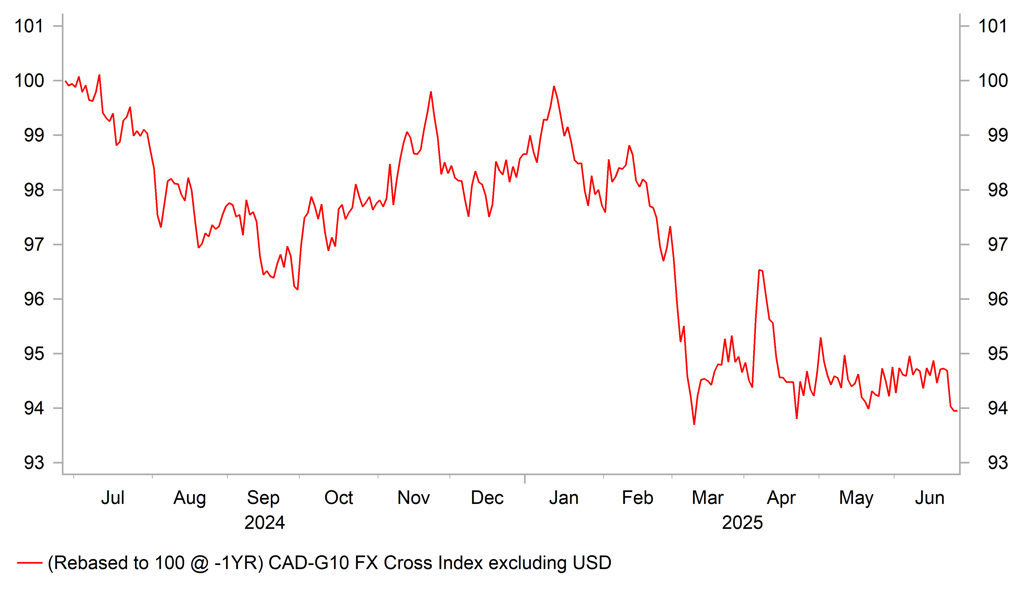
Source: Bloomberg, Macrobond & MUFG GMR
LOWER OIL PRICE REMAINS HEADWIND FOR CAD
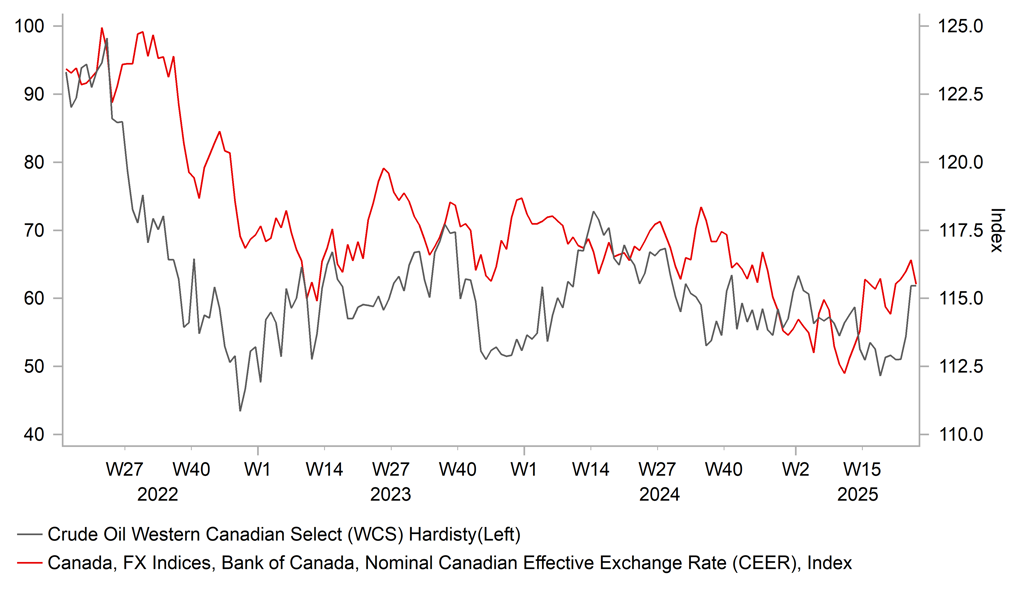
Source: Bloomberg, Macrobond & MUFG GMR
The sharp weakening of the USD this year has increased market attention on the risks of unhedged exposure to US asset holdings for foreign investors. Canadian investors are amongst the largest holders of US assets highlighting the deep financial integration between both countries. Unhedged exposure was less of a concern for Canadian investors when the USD was trending stronger against the CAD over the last four years which added to returns on US asset holdings. Another complication is that the correlation between the performance of USD/CAD and US equities has become less negative this year. When US equities have declined the USD has tended to strengthen providing a natural hedge but that relationship has weakened as well. The unfavourable developments are encouraging Canadian investors to consider increasing hedges on US asset holdings and potentially contributing to USD selling. The latest BIS Bulletin (click here) suggested that currency hedging by non-US investors holding US dollar securities made an important contribution to USD weakness in April and May especially by Asian investors.
The latest update on Canada’s exposure to US assets was released earlier this month on 11th June. The International Investment Position report for Q1 revealed that Canada’s net foreign asset position with the US fell by CAD177.8 billion to CAD1,553.3 billion. It was driven by a significant decline in the value of both portfolio (CAD82.2 billion) and direct (CAD64.7 billion) investment assets in the US largely resulting from lower US equity prices in Q1. StatCan noted that the value of Canadian portfolio investment in the US (CAD2.96 trillion) has been greater than the value of US portfolio investment in Canada (CAD1.96 trillion). The net portfolio investment position with the US reflects a net asset position in equity securities (CAD1.34 trillion) partially offset by a net liability position for debt securities (CAD338 billion). The increase in the net portfolio investment position with the US since the end of 2019 has been driven by equities especially in recent years when Canadian holdings of US equities have grown substantially. The value of US equity & investment fund shares held by Canadians has increased to CAD2.23 trillion in Q1 2025 up from CAD1.08 trillion in Q4 2019. It equates to around 72% of GDP in Q1 2025 compared to around 47% of GDP in Q4 2019. The potential for increased hedging flows to mitigate for the risk of the USD weakening further could continue to weigh down on USD/CAD which has already returned back to the mid-1.3000’s where it was trading between Q4 2022 and Q3 2024.
SHIFTING CORRELATION FOR USD/CAD & US EQUITIES
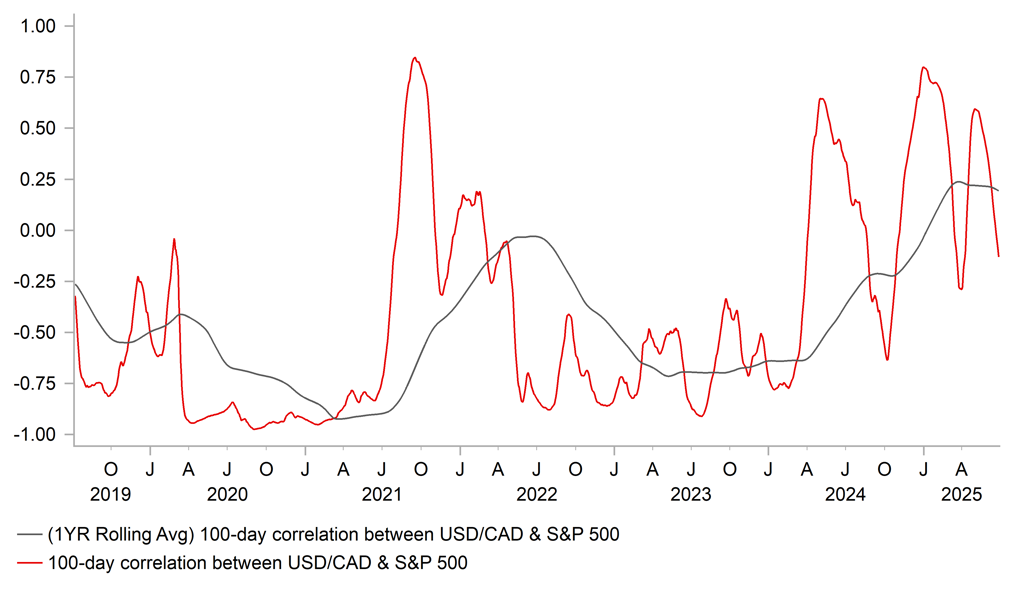
Source: Bloomberg, Macrobond & MUFG GMR
SHARP INCREASE IN EXPOSURE TO US EQUITIES
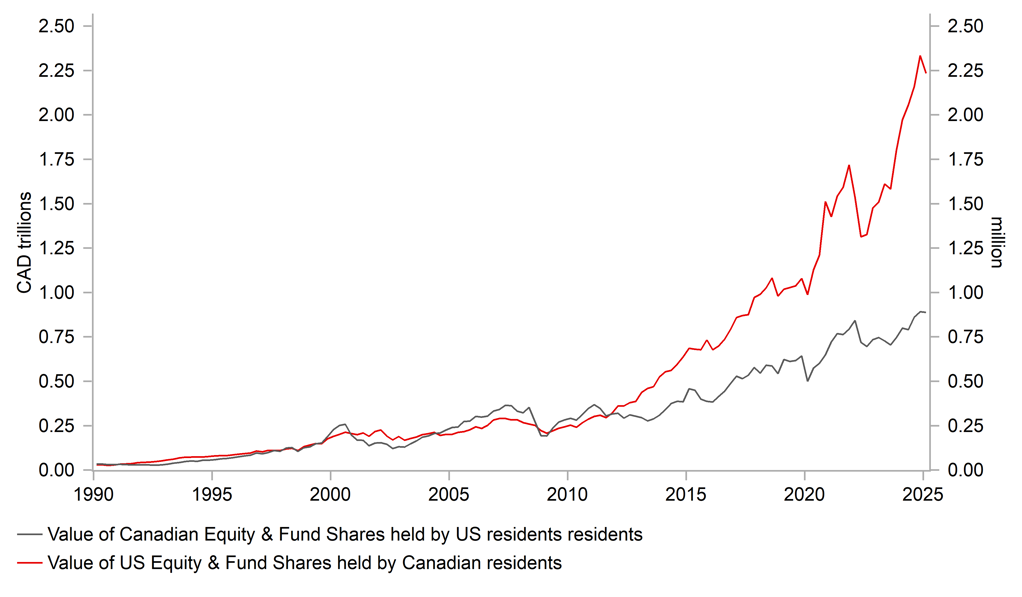
Source: Bloomberg, Macrobond & MUFG GMR
GBP: Outperformance may not last
The pound is currently the third best performing G10 currency this week and the de-escalation of the conflict between Israel and Iran and the sharp drop back in crude oil prices has had a positive impact on the pound. The UK is more vulnerable to a surge in energy prices given its lack of storage capacity results in a faster transmission into energy price increases than elsewhere so the 15% drop in crude oil prices from the peak last week is good news. UK natural gas prices are down over 20% and today hit the lowest level since July last year. The BoE GBP TWI is up 1.0% this week. The news overnight that the Trump administration is close to closing potentially ten trade deals ahead of the 9th July reciprocal tariff reintroduction has further helped financial market conditions. G10 FX volatility levels remain at or below long-term averages.
After an impressive 0.7% Q/Q GDP increase in Q1, the economy has slowed markedly and clearly the consumer remains cautious given the labour market looks to be weakening following the NICs tax increase that went live in April. That has had an impact on keeping inflation higher and this mix of still high inflation and increased job insecurity is weighing on consumer spending. Retail sales plunged 2.7% in May with food, household goods and clothing and footwear sales all falling notably. April m/m GDP fell 0.3% with the index of services growth falling 0.4%. Since the start of this year PAYE measured employment has dropped by 230k. This is by the worst performance of the labour market outside of covid since the data series began in 2015.
PM Kier Starmer has had to bat away a major party rebellion by removing some of the benefit cuts that had been pencilled in and schedule to be voted on in parliament. The Resolution Foundation estimates the net cost to be potentially GBP 3bn and follows a u-turn in the winter fuel allowance at a cost of GBP 1.5bn. The combined cost of these u-turns makes it increasingly likely that Chancellor Reeves will have to raise taxes in the autumn budget. Current GBP/Gilt yield correlations are negative so undermining fiscal credibility could fuel GBP selling (chart below). Governor Bailey this week repeated the MPC view that there is “strong evidence of labour market slack opening up”. While we maintain our view of a quarterly pace to MPC rate cuts, further labour market weakness will increase the prospect of back-to-back rates cuts in August and September with the BoE also now hinting at the chance of a cut to the pace of QT to help cap long-term Gilt yields.
Recent developments therefore suggest the outperformance of the pound is at risk of petering out. Given our bearish US dollar view, pound depreciation will be more evident versus non-dollar currencies. EUR/GBP can see further gains from here.
5MTH (YTD) CHANGE IN PAYROLL JOBS CLOSE AT 230K
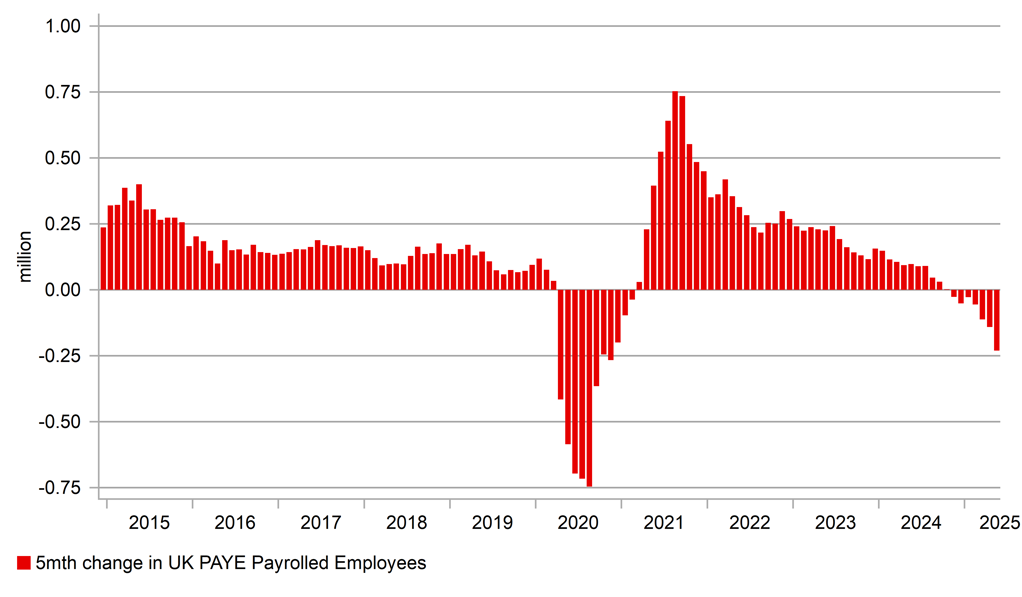
Source: Bloomberg, Macrobond & MUFG GMR
FISCAL SLIPPAGE A RISK TO GBP PERFORMANCE
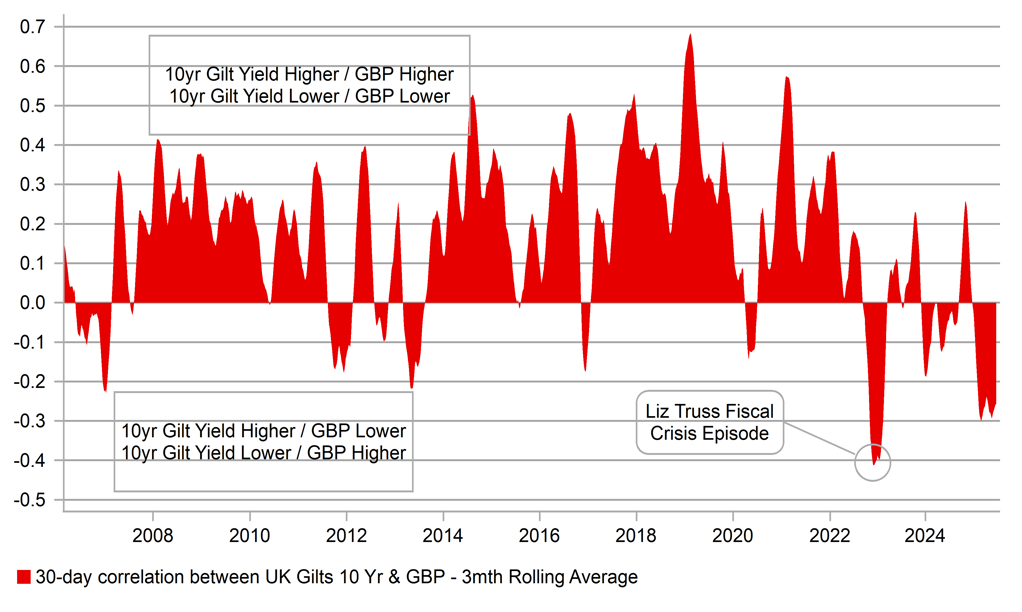
Source: Bloomberg, Macrobond & MUFG GMR
Weekly Calendar
|
Ccy |
Date |
BST |
Indicator/Event |
Period |
Consensus |
Previous |
Mkt Moving |
|
JPY |
30/06/2025 |
00:50 |
Industrial Production MoM |
May P |
3.5% |
-1.1% |
!! |
|
CNY |
30/06/2025 |
02:30 |
Manufacturing PMI |
Jun |
49.7 |
49.5 |
!! |
|
CNY |
30/06/2025 |
02:30 |
Non-manufacturing PMI |
Jun |
50.3 |
50.3 |
!! |
|
EUR |
30/06/2025 |
07:00 |
Germany Retail Sales MoM |
May |
0.5% |
-0.9% |
!! |
|
GBP |
30/06/2025 |
07:00 |
GDP QoQ |
1Q F |
-- |
0.7% |
!! |
|
CHF |
30/06/2025 |
08:00 |
KOF Leading Indicator |
Jun |
-- |
98.5 |
!! |
|
EUR |
30/06/2025 |
08:55 |
Germany Unemployment Change (000's) |
Jun |
-- |
34.0k |
!! |
|
GBP |
30/06/2025 |
09:30 |
M4 Money Supply YoY |
May |
-- |
3.2% |
!! |
|
EUR |
30/06/2025 |
13:00 |
Germany CPI YoY |
Jun P |
-- |
2.1% |
!!! |
|
EUR |
30/06/2025 |
20:00 |
ECB's Lagarde Speaks in Sintra |
!!! |
|||
|
JPY |
01/07/2025 |
00:50 |
Tankan Large Mfg Index |
2Q |
9.0 |
12.0 |
!!! |
|
EUR |
01/07/2025 |
09:00 |
HCOB Eurozone Manufacturing PMI |
Jun F |
-- |
49.4 |
!! |
|
GBP |
01/07/2025 |
09:30 |
S&P Global UK Manufacturing PMI |
Jun F |
-- |
47.7 |
!! |
|
EUR |
01/07/2025 |
10:00 |
CPI Estimate YoY |
Jun P |
-- |
-- |
!!! |
|
EUR |
01/07/2025 |
14:30 |
ECB Lagarde, Fed Powell, BOE Bailey & BOJ Ueda speak |
!!! |
|||
|
USD |
01/07/2025 |
15:00 |
ISM Manufacturing |
Jun |
48.5 |
48.5 |
!! |
|
USD |
01/07/2025 |
15:00 |
JOLTS Job Openings |
May |
-- |
7391k |
!! |
|
AUD |
02/07/2025 |
02:30 |
Retail Sales MoM |
May |
0.5% |
-0.1% |
!!! |
|
EUR |
02/07/2025 |
10:00 |
Unemployment Rate |
May |
-- |
6.20% |
!! |
|
USD |
02/07/2025 |
13:15 |
ADP Employment Change |
Jun |
-- |
37k |
!! |
|
CHF |
03/07/2025 |
07:30 |
CPI YoY |
Jun |
-- |
-0.1% |
!!! |
|
EUR |
03/07/2025 |
09:00 |
HCOB Eurozone Services PMI |
Jun F |
-- |
50.0 |
!! |
|
GBP |
03/07/2025 |
09:30 |
BoE Credit Conditions Survey |
!! |
|||
|
GBP |
03/07/2025 |
09:30 |
S&P Global UK Services PMI |
Jun F |
-- |
51.3 |
!! |
|
EUR |
03/07/2025 |
12:30 |
ECB Account of June Policy Meeting |
!! |
|||
|
USD |
03/07/2025 |
13:30 |
Trade Balance |
May |
-$67.2b |
-$61.6b |
!! |
|
USD |
03/07/2025 |
13:30 |
Change in Nonfarm Payrolls |
Jun |
116k |
139k |
!!! |
|
USD |
03/07/2025 |
13:30 |
Initial Jobless Claims |
-- |
-- |
!! |
|
|
USD |
03/07/2025 |
15:00 |
ISM Services Index |
Jun |
50.4 |
49.9 |
!!! |
|
USD |
03/07/2025 |
15:00 |
Durable Goods Orders |
May F |
-- |
-- |
!! |
Source: Bloomberg & MUFG GMR
Key Events:
- Market attention will return to economic data releases and the outlook for monetary and trade policies in the week ahead after geopolitical risks in the Middle East have faded following the ceasefire between Israel and Iran.
- The most important economic data release in the week ahead will be the latest nonfarm payrolls report for June on Thursday ahead of the 4th July US holiday. The report will attract even more attention than normal following dovish comments from Fed official over the past week including Governors Waller and Bowman who indicated that they could vote for a rate cut as early as next month. For the Fed to cut rates in July rather than waiting to see how much inflation picks up due to tariffs over the summer would require a weak nonfarm payrolls report show employment growth slowing below 100k and the unemployment rate jumping above the recent range between 4.0% and 4.2%.
- The outlook for monetary policy will be in focus at next week’s annual ECB Forum on Central Banking held at Sintra. ECB President Lagarde and Chief Economist Lane are both scheduled to speak alongside Fed Chair Powell, BoE Governor Bailey and BoJ Governor Ueda. The forum is entitled “Adapting to change: macroeconomic shifts and policy responses”. We would expect the policy discussion to touch on the challenges of setting monetary policy amidst heightened uncertainty and impact on outlook from trade and fiscal policy changes that are taking place. The main economic data releases in Europe will be the latest CPI reports for June released in the euro-zone and Switzerland. Slowing inflation is keeping pressure on both the ECB and SNB to lower rates further.
